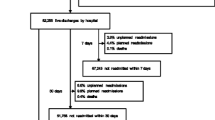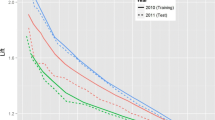Abstract
We compare statistical approaches for predicting the likelihood that individual patients will require readmission to hospital within 30 days of their discharge and for setting quality-control standards in that regard. Logistic regression, neural networks and decision trees are found to have comparable discriminating power when applied to cases that were not used to calibrate the respective models. Significant factors for predicting likelihood of readmission are the patient’s medical condition upon admission and discharge, length (days) of the hospital visit, care rendered during the hospital stay, size and role of the medical facility, the type of medical insurance, and the environment into which the patient is discharged. Separately constructed models for major medical specialties (Surgery/Gynecology, Cardiorespiratory, Cardiovascular, Neurology, and Medicine) can improve the ability to identify high-risk patients for possible intervention, while consolidated models (with indicator variables for the specialties) can serve well for assessing overall quality of care.
Similar content being viewed by others
Notes
The average ICD-9 count was 142; the median was 29. In future research, alternative methods of incorporating counts of comorbidities and prior admissions will be explored.
References
Jencks SF, Williams MV, Coleman EA (2009) Rehospitalizations among patients in the medicare fee-for-service program. N Engl J Med 360(14):1418–1428
Medicare’s Hospital Readmission Reduction Program FAQ (2013) www.acep.org. Retrieved, April 4, 2014, from https://www.acep.org/Legislation-and-Advocacy/Practice-Management-Issues/Physician-Payment-Reform/Medicare-s-Hospital-Readmission-Reduction-Program-FAQ/
Lee EW (2012) Selecting the best prediction model for readmission. J Prev Med Public Health 45(4):259–266
Benbassat J, Taragin M (2000) Hospital readmissions as a measure of quality of health care: advantages and limitations. Arch Intern Med 160(8):1074–1081
Halfon P, Eggli Y, van Melle G, Chevalier J, Wasserfallen JB, Burnand B (2002) Measuring potentially avoidable hospital readmissions. J Clin Epidemiol 55(6):573–587
van Walraven C, Dhalla IA, Bell C, Etchells E, Stiell IG, Zarnke K, Forster AJ (2010) Derivation and validation of an index to predict early death or unplanned readmission after discharge from hospital to the community. Can Med Assoc J 182(6):551–557
Desai MM, Stauffer BD, Feringa HH, Schreiner GC (2009) Statistical models and patient predictors of readmission for acute myocardial infarction a systematic review. Cir Cardiovasc Qual Outcome 2(5):500–507
Bottle A, Aylin P, Majeed A (2006) Identifying patients at high risk of emergency hospital admissions: a logistic regression analysis. J R Soc Med 99(8):406–414
Omar Hasan MBBS MPH, Meltzer DO, Shaykevich SA, Bell CM, Kaboli PJ, Auerbach AD, Schnipper JL (2010) Hospital readmission in general medicine patients: a prediction model. J Gen Intern Med 25(3):211–219
Silverstein MD, Qin H, Mercer SQ, Fong J, Haydar Z (2008) Risk factors for 30-day hospital readmission in patients≥ 65 years of age. Proc (Baylor Univ Med Cent) 21(4):363
Kansagara D, Englander H, Salanitro A, Kagen D, Theobald C, Freeman M, Kripalani S (2011) Risk prediction models for hospital readmission: a systematic review. JAMA 306(15):1688–1698
Ottenbacher KJ, Linn RT, Smith PM, Illig SB, Mancuso M, Granger CV (2004) Comparison of logistic regression and neural network analysis applied to predicting living setting after hip fracture. Ann Epidemiol 14(8):551–559
Eftekhar B, Mohammad K, Ardebili HE, Ghodsi M, Ketabchi E (2005) Comparison of artificial neural network and logistic regression models for prediction of mortality in head trauma based on initial clinical data. BMC Med Inform Decis Mak 5(1):3
Horwitz L, Partovian V, Lin Z, Herrin J, Grady J, Conover M, Montague J, Dillaway C, Bartczak K, Suter L, Ross J, Bernheim S, Krumholz H, Drye E (2012), Hospital-wide all-cause unplanned readmission measure: final technical report to the CMS, Yale University, 98 pp
Donzé J, Aujesky D, Williams D, Schnipper JL (2013) Potentially avoidable 30-day hospital readmissions in medical patients: derivation and validation of a prediction model. JAMA Int Med 173(8):632–638
Charlson M, Szatrowski TP, Peterson J, Gold J (1994) Validation of a combined comorbidity index. J Clin Epidemiol 47(11):1245–1251. doi:10.1001/jamainternmed.2013.3023
Author information
Authors and Affiliations
Corresponding author
Rights and permissions
About this article
Cite this article
Kulkarni, P., Smith, L.D. & Woeltje, K.F. Assessing risk of hospital readmissions for improving medical practice. Health Care Manag Sci 19, 291–299 (2016). https://doi.org/10.1007/s10729-015-9323-5
Received:
Accepted:
Published:
Issue Date:
DOI: https://doi.org/10.1007/s10729-015-9323-5




